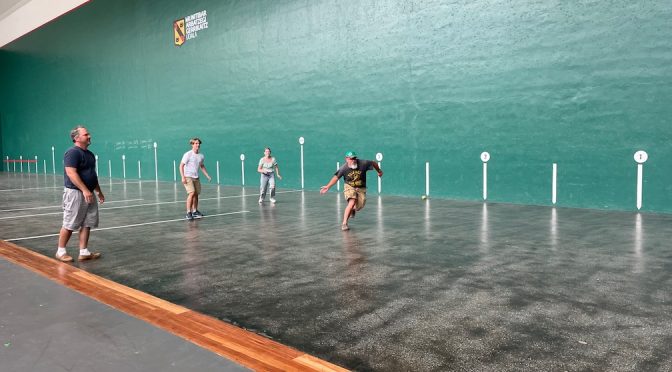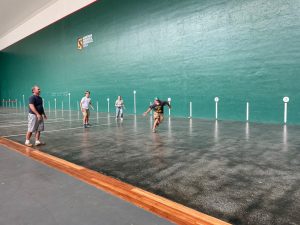Before we got lunch at the txoko, we passed by the town plaza. It is always a magical time for me, as people are wandering the town and I’ve spent enough time there that I recognize so many faces, and they recognize me. I don’t always know everyone’s names, but there is just something special about feeling part of the community for me. We then stopped at the Munitibar fronton where some of the local boys were playing handball. We watched as they effortlessly smashed the ball with their hands, sending it ricocheting off of the front stone wall. We decided to take our turn – me, my daughter, my best friend, and his son. It was a humbling experience, as none of us could even get the serve off much less return it. The ball doesn’t bounce like anything we are used to – you have to hit it a lot harder. But it was still fun to be out on the fronton.
- Ball games are almost as old as human civilization and have been developed independently around the globe. The versions played in Western Europe arose from the Romans, who brought these types of games with them as they expanded throughout the continent. Games in which a ball was hit with the hand were particularly popular in France, and the Basque versions – there are several – likely grew out of that. The importance of pelota to Basque society is reflected in the fact that discoidal stelae from as far back as 1629 feature the pelotari profession. Mentions of pelota in the Basque Country go as far back as 1331. However, the modern form played in a fronton against a wall is more recent, with first mentions in 1750 in the town of Oñati.
- While I was told that there has been some resurgence in cesta punta/jai alai in recent years, during the whole time I’ve known the Basque Country, handball has been by far the most dominant and popular variety of pelota vasca. Handball comes in two varieties, singles and pairs – both are very popular.
- The rules are relatively simple: each time the ball is struck, it has to hit the front wall once and only once and it can bounce no more than once within the playing area. If it bounces more than once or the first bounce is outside the playing area, the opposing team gets a point. On the serve, the ball has to fall between two designated lines after bouncing off the front wall, otherwise it is a lost point to the opposing team. The game is played to 22 points and there is no time limit.
- The ball itself is a bit surprising. It isn’t soft or rubbery. Rather, it is made of boxwood, which is covered by layers of latex and wool, and then wrapped in a layer of leather. To protect their hands from the hard ball, players cut small strips of different types of adhesive tape that they form into particular shapes depending on the exact place on the hand where they will be placed. They thus create a set of small, custom-made studs that cover the inside of their hands. Even with this protection, injuries can and do occur. Pelotaris are famous for having hands of steel. I’ve seen documentaries of older pelotaris whose hands are a mangled mess.
- A tournament to crown the best handball player was begun in 1940 by the Federación Española de Pelota. For the first decade, it was held every 2 years, but in 1950 it became an annual event. That first championship in 1940 was won by Atano III (Mariano Juaristi Mendizábal of Azcoitia, Gizpuzkoa), while Retegi II (Julián Retegui Barberia from Eratsun, Nafarroa) has won the most championships – 11 total, including an astounding 9 in a row.
- Of the Basque provinces, Nafarroa boasts by far the most champions, with pelotaris from Nafarroa winning 46 of the 79 txapelas. Gipuzkoa is second with 18 and Bizkaia next with 11.
Primary sources: Pelota mano, Wikipedia; Campeonato manomanista, Wikipedia; Historia de la Pelota, EuskalPilota; ‘La increíble historia de la pelota vasca’ contada desde Iruñea, Naiz; Pelota Mano, EuskoGuide




Greetings,
I am so happy for you that you felt the “special feeling” of being part of the community. It is a feeling that is difficult to put into words. Very nice and thank you for sharing.
Monique
Is there any place online where the schedules are posted? I found a few different schedules, but nothing comprehensive.
Also, is there a place online to buy tickets, or do you just buy them day of at the stadium/court?
Hi Evan, I guess I don’t know well. I think there are apps you can get that show the schedule and you can buy tickets that way but I’ve never tried to use one. My cousin tried last time we were in the Basque Country so I think there is some system like that but I’m not sure how to find it.
No worries, I appreciate the reply! I will come back and update if I find anything. Thank you.
Sounds great. I’d be very interested in anything you learn about this.
There are some websites to check match schedules and buy tickets online.
. Pelota Mano / Hand ball (2 companies operate)
https://www.baikopilota.eus/entradas/
https://aspepelota.eus/cartelera/
. Jai Alai / Cesta Punta.
https://www.eramanjaialai.com/sarrerak-entradas/
Good luck
Iñigo Kareaga – Aulesti – Euskal Herria